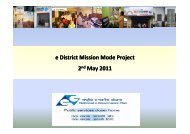State Mission Mode Project e-district - Department of Electronics and ...
State Mission Mode Project e-district - Department of Electronics and ...
State Mission Mode Project e-district - Department of Electronics and ...
Create successful ePaper yourself
Turn your PDF publications into a flip-book with our unique Google optimized e-Paper software.
Study Report on Assessment <strong>of</strong> the <strong>Mode</strong>l e-<strong>district</strong>s<br />
Funding for entire project life cycle<br />
For e-<strong>district</strong>s to be sustainable <strong>and</strong> effective, the funds should be budgeted for the entire project<br />
life cycle. A typical IT project would have a lifecycle <strong>of</strong> 4-5 years, <strong>and</strong> if the funding is not<br />
budgeted for the full lifecycle, the IT project would be prone to failures. As observed in the model<br />
<strong>district</strong>s, the IT infrastructure <strong>and</strong> s<strong>of</strong>tware were put up during the project implementation /<br />
launch stage, with no provisions for maintenance <strong>and</strong> upgradation afterwards. At Thiruvarur,<br />
currently there is an urgent requirement for upgradation <strong>of</strong> the computing infrastructure that have<br />
hitherto become obsolete, due to lack <strong>of</strong> funds available. Similarly, at Palakkad, the project was<br />
launched with ADB grant, but now there are no funds for the maintenance or further development<br />
<strong>of</strong> s<strong>of</strong>tware. Continuity <strong>of</strong> financial support is essential for implementation <strong>of</strong> e-<strong>district</strong>. Funding<br />
for the project life cycle can be budgeted either with the setup cost or from the revenue model.<br />
Financially sustainable revenue model<br />
As e-<strong>district</strong> is proposed to be the backend for delivery <strong>of</strong> services through CSCs, there is a need for<br />
a financially sustainable model <strong>of</strong> revenue generation for e-<strong>district</strong>s to remain viable <strong>and</strong><br />
operational after the initiation <strong>and</strong> establishment phase. The e-<strong>district</strong>s are going to incur<br />
additional expenses in terms <strong>of</strong> stationery, consumables, hardware <strong>and</strong> s<strong>of</strong>tware maintenance <strong>and</strong><br />
upgradation, digitization etc. In the <strong>district</strong>s visited, the revenue model for the automating <strong>and</strong><br />
sustaining backend processes is thought <strong>of</strong> in case <strong>of</strong> G<strong>and</strong>hinagar <strong>and</strong> Ahmedabad, where capital<br />
expenses on Computer Hardware <strong>and</strong> S<strong>of</strong>tware are being met by the government, <strong>and</strong> operational<br />
expenses <strong>and</strong> maintenance expenses are being met with through the PPP model. At Palakkad, there<br />
are no citizen services being delivered from which user charges can be levied. At Thiruvarur, the<br />
user charges are sufficient only for operational expenses, the maintenance <strong>and</strong> upgradation<br />
expenses can not be met by the user charges. As it was seen at West Godavari, utility payments<br />
<strong>and</strong> other B2C services help ensure sustainability <strong>of</strong> the CSC’s, <strong>and</strong> a centralized approach might be<br />
adopted to provide various B2C <strong>and</strong> utility services as part <strong>of</strong> e-<strong>district</strong> MMP.<br />
Service levels between e-<strong>district</strong> <strong>and</strong> the departments, CSCs<br />
In e-<strong>district</strong> MMP, the service levels for the delivery <strong>of</strong> citizen services are well defined, a back to<br />
back commitment from the CSC <strong>and</strong> departments for providing these services would be essential.<br />
Citizen awareness <strong>and</strong> appreciation <strong>of</strong> the services would put the onus on the departments to<br />
sustain the service levels <strong>and</strong> explore enhancements. As observed in Ahmedabad <strong>and</strong> G<strong>and</strong>hinagar,<br />
due to lack <strong>of</strong> backend computerization, the emphasis <strong>and</strong> burden <strong>of</strong> bringing the documentary<br />
evidence is shifted to the citizen to deliver the required services in prescribed time limits. This<br />
does not result in lesser service delivery time for the citizen in effect, as he is running around to<br />
gather all the documents required here <strong>and</strong> there. A true BPR effort would result in the use <strong>of</strong><br />
existing systems <strong>and</strong> databases like l<strong>and</strong> records, l<strong>and</strong> revenue records, l<strong>and</strong> registration<br />
21




